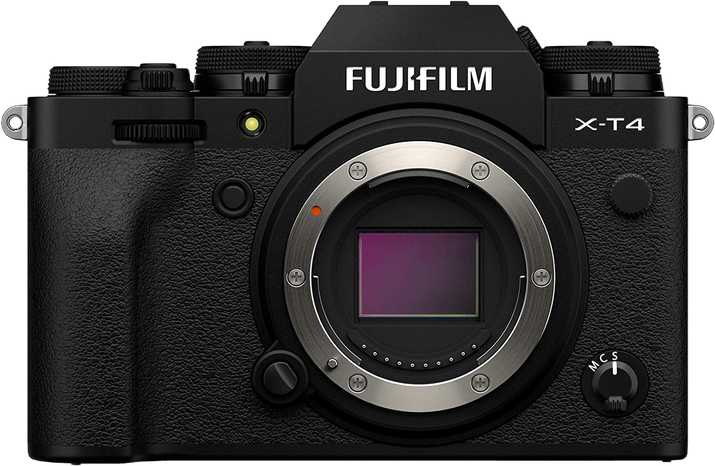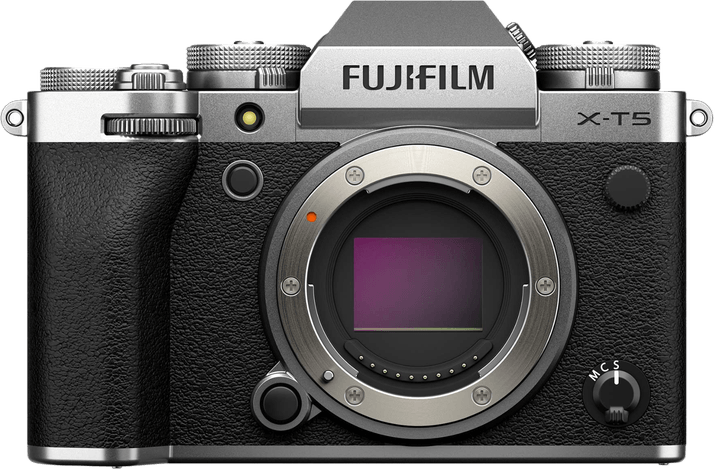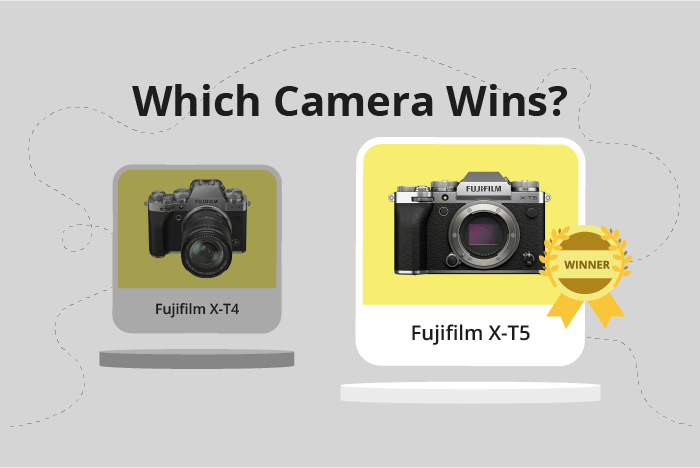Fujifilm X-T4 vs X-T5 Comparison
Fujifilm X-T4

Fujifilm X-T5

The Fujifilm X-T5 outperforms the X-T4 with a score of 81/100 compared to 76/100. Both cameras share similarities as mirrorless cameras, announced at a launch price of $1699, and released in 2020 and 2022, respectively. The X-T5 has the edge with its compact size, measuring 130 x 91 x 64mm, and lighter weight of 557g, making it more portable than the X-T4, which is 135 x 93 x 84mm and weighs 607g.
Although the X-T4 has a lower score, it remains a reliable camera with its own merits. However, the X-T5’s improved score and lighter design make it a more appealing option for photographers seeking a balance between performance and portability. Both cameras offer quality photography experiences, with the X-T5 standing out as the winner in this comparison.
Fujifilm X-T4 vs X-T5 Overview and Optics
The Fujifilm X-T5 triumphs in the optics comparison with a score of 81/100, compared to the Fujifilm X-T4’s score of 73/100. Both cameras share several common specifications, including a CMOS sensor type, APS-C sensor size, Fujifilm X lens mount, and image stabilization. Despite these similarities, the X-T5 outperforms the X-T4 in certain aspects.
The X-T5 has a higher megapixel count of 40 compared to the X-T4’s 26 megapixels. This results in greater image resolution and detail, which is beneficial for photographers who need to produce large prints or crop their images tightly. Additionally, the X-T5 is equipped with a more advanced processor, the X-Processor 5, which improves overall performance and image quality.
However, the X-T4 has a faster shooting speed of 20 frames per second (fps), while the X-T5 can only reach 15 fps. This makes the X-T4 a better choice for photographers who need to capture fast-moving subjects or situations, such as sports and wildlife photography.
Considering these points, the Fujifilm X-T5 offers superior image quality due to its higher megapixel count and advanced processor. This makes it an excellent choice for photographers who prioritize image resolution and detail. On the other hand, the Fujifilm X-T4 is more suitable for those who require a faster shooting speed for capturing action-packed scenes. Ultimately, the choice between these two cameras will depend on the specific needs and preferences of the photographer.
Fujifilm X-T4 vs X-T5 Video Performance
The Fujifilm X-T4 outperforms the Fujifilm X-T5 in video capabilities with a score of 91/100, a 4-point lead over the X-T5’s 87/100. Both cameras share common features, such as 4K and 6K video resolutions, time-lapse functionality, and similar video dimensions. However, the X-T4 has a clear advantage in some aspects, while the X-T5 excels in others.
The X-T4’s superiority lies in its higher maximum video frame rate of 120fps, compared to the X-T5’s 60fps. This allows for smoother and more detailed slow-motion footage, providing greater creative flexibility for videographers. The X-T4’s video dimensions of 4096 x 2160 also ensure high-quality 4K footage.
On the other hand, the X-T5 stands out with its 6K video resolution and larger video dimensions of 6240 x 4160. This higher resolution allows for more detailed and sharper footage, which can be an advantage for those who prioritize video quality over frame rate.
Considering these factors, the Fujifilm X-T4 is the better choice for videographers who value smooth slow-motion capabilities and a balance of quality and performance. The X-T5, while offering superior resolution, may not be as versatile due to its lower frame rate. Both cameras, however, provide excellent video functionality with built-in time-lapse features, making them suitable options for various video projects.
Fujifilm X-T4 vs X-T5 Features and Benefits
The Fujifilm X-T4 and X-T5 both have a feature score of 85/100, making them equal in this aspect. They share several specifications, including a 3-inch screen size, touchscreen capability, flip screen, absence of GPS, and the presence of WIFI and Bluetooth connectivity.
The Fujifilm X-T4 has a screen resolution of 1,620,000 dots, while the X-T5 has a higher screen resolution of 1,840,000 dots. This means the X-T5 offers a clearer and more detailed display. As a result, the X-T5 is better in terms of screen resolution, providing an improved viewing experience for users.
On the other hand, the Fujifilm X-T4 does not surpass the X-T5 in any specific feature, as they share the same score and have identical specifications in other aspects. Therefore, it is not possible to claim that the X-T4 is better than the X-T5 in any particular area.
Taking these points into consideration, it is clear that the Fujifilm X-T5 has an advantage over the X-T4 in terms of screen resolution, while the other features are identical between the two cameras. Users who prioritize a higher screen resolution may prefer the X-T5, while others may find both cameras equally suitable for their needs. Ultimately, the choice between these two cameras comes down to personal preference and individual requirements.
Fujifilm X-T4 vs X-T5 Storage and Battery
The Fujifilm X-T5 wins in the storage and battery category with a score of 76/100, while the Fujifilm X-T4 scores 73/100. Both cameras have two memory card slots and accept SD, SDHC, and SDXC cards. They also both use the NP-W235 battery type and offer USB charging.
The X-T5 outperforms the X-T4 in terms of battery life, providing 580 shots compared to the X-T4’s 500 shots. This longer battery life makes the X-T5 more convenient for extended shooting sessions. However, the X-T4 has an advantage in memory card compatibility, as it supports faster UHS-II cards, while the X-T5 only supports UHS-I cards. This means the X-T4 can achieve higher transfer speeds, which is beneficial for photographers who need to quickly transfer large amounts of data.
Despite the slight differences, both cameras offer reliable storage and battery options. The X-T5’s longer battery life makes it a better choice for those prioritizing shooting time, while the X-T4’s faster memory card compatibility may appeal to users requiring quicker data transfer.
Alternatives to the Fujifilm X-T4 and X-T5
Are you still undecided about which camera is right for you? Have a look at these popular comparisons that feature the Fujifilm X-T4 or the Fujifilm X-T5:

